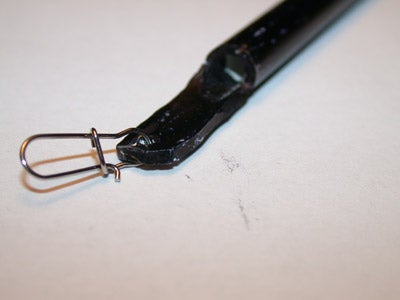| I dreamed up this idea one afternoon after a match at which a number of anglers, frustrated with unhittable bream bites resorted to using ‘The Method’.
It has long been obvious to me that our ideas about where hookbaits, etc, end up, if diagrams in magazines are any guide, is nonsense. When you cast out a paternoster feeder rig, the feeder ends up furthest from you and the hooklink, having travelled vertically to the bottom, is coiled up on the bottom with the hook in the middle of it. Say you have used an 18-inch hooklink. That means that any fish which finds your bait COULD move directly away from you and pull the tip round, or could equally well move towards you and slack-line you. In either case, it is free to move 18 inches from the spot at which it picked up the bait before anything registers at the quivertip.
If you fish with fairly balanced tackle on a windy day, slack-liners can be hard to spot, the bow in the line continuing to keep the tip pulled round. With any undertow or current, this is doubly so. If you can avoid slack-liners, you are on the winning side. The Method works for two main reasons; the bait is in with the groundbait ball, so more likely to be found; and it’s a self-hooking rig, so the ‘bite’ is actually a hooked fish. You don’t find out about the ones that don’t hook themselves until you reel in your baitless hook. If you want a running leger rig – one in which the fish is free to take line so you can see the bite developing – you could, of course, fish a running leger rig with a two-inch hooklink. It would work, but there’s an evens chance of the hooklength whirling round the feeder swivel and tangling, and bang goes the running leger effect. The Leger Tube So enter the leger tube – a method of presenting the bait right next to the feeder, without tangling and with a full running leger effect. The moment a fish takes the bait, you get an indication, no matter which direction the fish heads. You can watch the bites ‘develop’ and have all the control The Method robs you of.   Basically, it’s a long tube with a small hole in one end and at the other, an attachment for the feeder. To use it, you feed the reel line in through the small hole, out of the other end of the tube, thread on a bead small enough to run INSIDE the tube tie on a microswivel or ring, then tie your hooklength to it. The hooklength should be slightly longer than the tube. Attach the feeder to the leger tube, bait up and away you go. If a fish takes the bait, it pulls the hooklength through the tube, and your tip goes round. You know the rest.
This is an idea in its infancy. I have made the prototype and will be using it this winter, but FISHINGmagic’s ingenious readers may like to make their own and see how it performs. I can say this; it casts like a polaris missile, and first indications are that it completely eliminates hooklength tangling. | ||
|
Welcome!Log into your account












